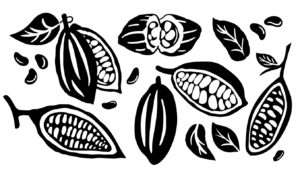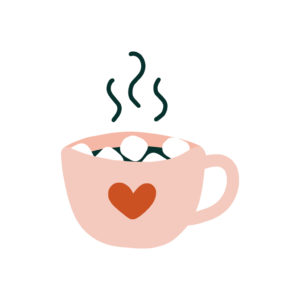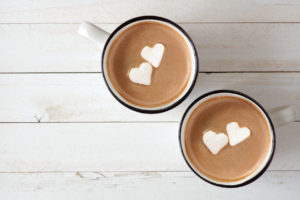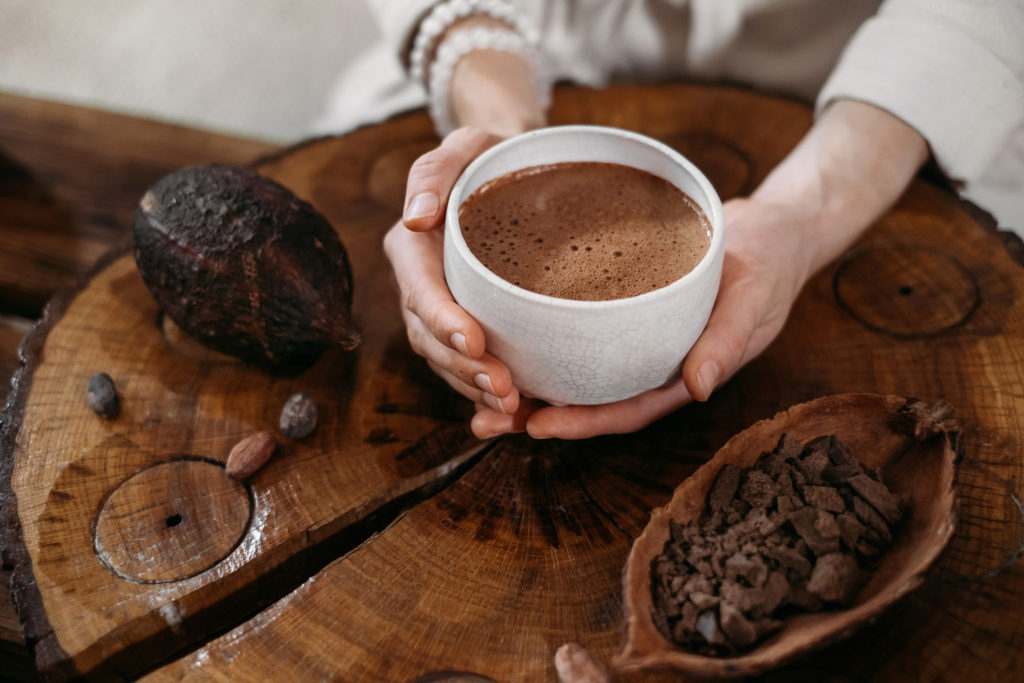In our modern culture, it’s easy to overlook the rich tapestry of history and tradition accompanying something as seemingly mundane as hot chocolate. Today is National Hot Chocolate Day – a day that beckons us to ponder not just a steaming cup of cocoa but also the rich symbolism that chocolate has woven through the ages. From the ancient rituals of the Maya and Aztecs to our cozy winter evenings, chocolate, in its various forms, has been a constant companion, a symbol evolving with time yet perennially touching the human spirit.
For this blog post, I am taking us on a little journey, tracing the path of chocolate from its sacred roots to its modern-day avatar as a vessel of warmth and nostalgia. As I sat to write this, it was appropriate to sip on a cup of cacao I had just brewed using a French press. Recently, this has become my morning ritual as I cut down on my caffeine intake. Brewing cacao has replaced my second cup of coffee. (If you’re curious about brewed cacao, I have a link to my recipe at the bottom of this post.)

Sacred Brew of the Ancients
Our story begins in the lush rainforests of Mesoamerica, where the cacao tree first bore its precious fruit. The ancient Olmecs, thriving around 1500 BCE, are often credited with the first use of cacao.
This drink of the Olmecs was nothing close to the sweet, creamy concoction we relish today. In its original form, cacao was a far cry from the modern chocolate bar, or the steaming cup of hot chocolate the barista behind the counter asked if you want whip with it. This stuff was an extremely bitter brew- an acquired taste- revered for its mystical properties and divine origin.
Sips of History
The Maya, flourishing from 250 to 900 CE, inherited and refined the Olmecs’ use of cacao. In their cosmology, the cacao tree was a sacred bridge between heaven and earth, its roots entrenched in the underworld and branches reaching the celestial realm. This profound spiritual connection was mirrored in their daily lives. The Mayans consumed chocolate as a frothy, spicy drink, often mixed with chili peppers, honey, and vanilla. It was integral to their religious ceremonies, used in baptisms and marriages, symbolizing rebirth and union. (I can’t help but imagine how much I would have enjoyed Sunday mornings as a kid if the church my parents attended would’ve served hot chocolate! Instead, church always smelled like coffee and basements.)
Mystic Mugs
For the ancient Maya and Aztecs, chocolate was a divine elixir, consumed as a bitter, frothy beverage during these sacred rituals. This bitter concoction was considered a drink of the gods, a medium through which mortals could commune with the divine. (When I add honey, I can get there!)
In this context, chocolate symbolizes a profound connection with the celestial realm. It was not merely a drink but a sacrament, a vital part of religious and royal ceremonies. Imagine the solemnity of an Aztec ritual, where priests, adorned in elaborate headdresses, offered cacao to the gods, imploring for their favor. In these moments, chocolate transcended its physical form, becoming a bridge between the earthly and the divine.

Chocolate Money
We uncover another layer of symbolism as we delve deeper into the ancient Mesoamerican civilizations. For the Aztecs, cacao beans were not just ingredients for a sacred beverage but a currency that fueled an empire. Cacao beans were traded for goods and services, a tangible measure of wealth and power.
In this context, chocolate symbolizes economic and social status. It was a luxury, a privilege of the affluent. Consuming chocolate was akin to displaying one’s wealth and influence. So, think about it next time you sip on your hot chocolate – you’re basically drinking liquid gold.

Pour Some Sugar on It
With the arrival of the Spanish conquistadors, chocolate began its journey across the ocean, undergoing a metamorphosis that would endear it to a whole new world. In Europe, chocolate became a coveted luxury among the aristocracy.
Here, chocolate symbolizes refinement and sophistication. European high society relished this exotic beverage, now sweetened with sugar and spiced with vanilla. Chocolate houses became the hubs of social and intellectual discourse. They were the Starbucks of their time, minus the Wi-Fi.
Democratization of Chocolate
The Industrial Revolution was like the superhero of this tale, making chocolate accessible to the masses. The invention of the cocoa press and subsequent innovations made chocolate cheaper and more widely available.
In this democratization, chocolate symbolized comfort and accessibility. It became a beverage of the people, a simple pleasure within everyone’s reach. The symbolism here is poignant – from a divine elixir to an everyday comfort, chocolate’s journey mirrors our society’s evolution.

A Hug in a Cup
In contemporary times, hot chocolate evokes nostalgia and warmth. It’s fascinating how something as simple as chocolate can be a testament to the richness of human experience.
So, let’s raise our mugs to this humble bean that has played a significant role in human culture. On National Hot Chocolate Day, take a moment to appreciate the rich history in your cup. And remember, in every sip, there’s a story, a legacy that spans centuries.
As for me, I’ve got my own little brewing ritual with a French press and a handful of ingredients that turn my morning brew into a cup of historical wonder. Click here for my brewed cacao recipe. And hey, if you have a favorite recipe or a unique way you enjoy your hot chocolate or cacao, I’m all ears! Share your chocolatey secrets in the comments. Let’s make every day a chocolate adventure!

Here’s my morning brewed cacao recipe
I use a single serve (12oz.) French press and place four tablespoons of roasted cacao nibs into the bottom of the press.
Heat 11 oz of water to boiling (I have a kettle that is set to 212 degrees Fahrenheit)
Pour the boiling water over the nibs in the French press and stir them before fitting the top of the press back on. Wait to depress the plunger; let it steep. I steep mine for at least 20 minutes, and sometimes longer (I let mine steep while I enjoy my only cup of coffee for the day.)
After steeping, I take the top of the French press off and stir once more before pushing down on the plunger.
Then, I depress the plunger and pour the contents into a mug. I add a tablespoon of honey and either a little steamed milk or a dash of heavy cream depending on what I’m using that day. To finish it off I grate a stick of Ceylon cinnamon and add a sprinkle of cayenne pepper. (I love how the fresh cinnamon smells floating on the top every time I take a sip). If you don’t like the heat of cayenne, you can skip this step; however, there are health benefits to adding chili to cacao*. I love the heat and add chilis to anything I can.
*Capsaicin is the primary carotenoid that causes the heat sensation we get when we eat chili. Capsaicin is an anti-inflammatory, and fighting inflammation in the body has many delicious benefits beyond a festive party in your mouth! Decreasing inflammation contributes to heart health and boosts metabolism, supporting weight loss. (Adding sugar and heavy cream might counteract the weight loss component, so you can skip it if you like or at least be mindful of your portions.) Interestingly, cacao contains rich plant polyphenols that are potent anti-inflammatory agents as well, so think of cacao as a powerful antioxidant. I’ll write more about the health benefits of cacao in a blog post I’m writing for #WorldChocolateDay on July 7th…so more on that later! In the meantime, keep in mind that the higher the cacao content of anything you consume, the greater the health benefits. If you’re consuming chocolate for its health benefits, you’ll want your chocolate to contain at least 70% cacao.



